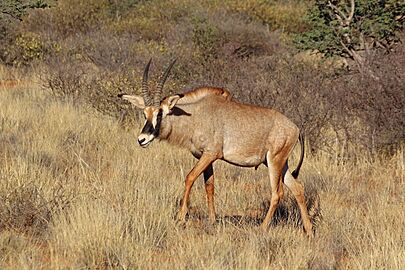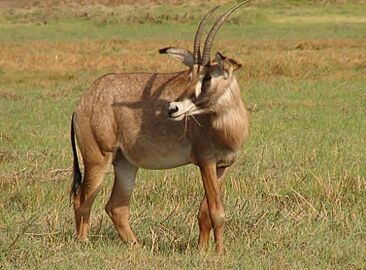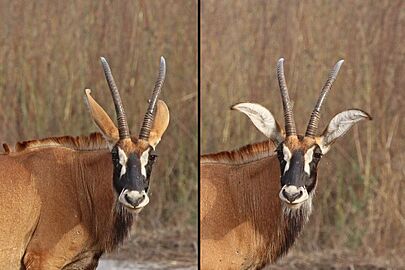Roan antelope facts for kids
Quick facts for kids Roan antelope |
|
|---|---|
 |
|
| H. e. equinus, Eswatini | |
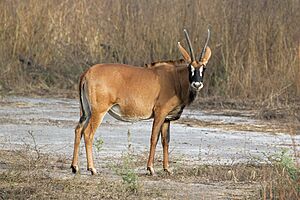 |
|
| H. e. koba in Senegal | |
| Conservation status | |
| Scientific classification | |
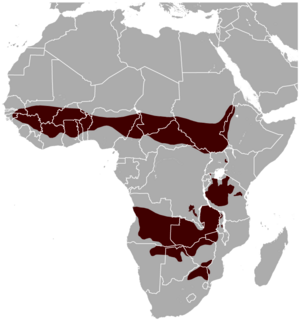 |
|
| range | |
| Synonyms | |
|
List
Antilope equina É. Geoffroy Saint-Hilaire, 1803
H. aethiopica (Schinz, 1821) H. aurita (C. H. Smith, 1827) H. barbata (C. H. Smith, 1827) H. docoi Gray, 1872 H. dogetti de Beaux, 1921 H. gambianus Sclater and Thomas, 1899 H. jubata (Goldfuss, 1824) H. rufopallidus Neumann, 1899 H. truteri (J. B. Fischer, 1829) H. typicus Sclater and Thomas, 1899 |
The roan antelope (Hippotragus equinus) is a large antelope that lives in the savannas of Africa. You can find them in western, central, and southern parts of the continent. They are named for their reddish-brown color, which is called "roan." Their bellies are lighter, and they have white eyebrows and cheeks. Their faces are black, but females have lighter faces. Roan antelopes have short, upright manes and small beards. They also have noticeable red nostrils.
These antelopes are among the biggest in the world. From head to tail, they measure about 190 to 240 centimeters (75 to 94 inches). Their tail is about 37 to 48 centimeters (15 to 19 inches) long. Male roan antelopes weigh between 242 and 300 kilograms (534 to 661 pounds). Females are a bit lighter, weighing 223 to 280 kilograms (492 to 617 pounds). Their shoulders are usually 130 to 140 centimeters (51 to 55 inches) high.
Contents
Meet the Roan Antelope Family
The roan antelope belongs to a group of animals called the Hippotragus genus. This group also includes the sable antelope (H. niger). Sadly, another animal in this group, the bluebuck (H. leucophaeus), is now extinct. All these animals are part of the Bovidae family, which includes cows, goats, and sheep.
A French scientist named Étienne Geoffroy Saint-Hilaire first described the roan antelope in 1803. The name equinus comes from the Latin word equus, which means "horse-like." This name was given because the roan antelope looks a bit like a horse.
Scientists have studied the DNA of these antelopes. In 1996, they looked at the DNA from a bluebuck specimen. They found that the bluebuck is a different species, not just a type of roan antelope. This helps us understand how these animals are related.
Different Types of Roan Antelopes
There are six different types, or subspecies, of roan antelopes. They live in different parts of Africa:
- H. e. bakeri: Found in Sudan in East Africa.
- H. e. cottoni: Lives in Angola, Botswana, parts of the Democratic Republic of the Congo, Malawi, and Zambia in Southern Africa.
- H. e. equinus: Found in Mozambique, South Africa, and Zimbabwe in Southern Africa.
- H. e. koba: Lives from Senegal to Benin in West Africa.
- H. e. langheldi: Found in Burundi, parts of the Democratic Republic of the Congo, Ethiopia, Kenya, Rwanda, South Sudan, Tanzania, and Uganda in East Africa.
- H. e. scharicus: Lives in Cameroon, the Central African Republic, Chad, and eastern Nigeria in Central Africa.
-
H. e. equinus, South Africa
-
H. e. cottoni, Zambia
-
H. e. koba showing both sides of ears, Senegal
What Do Roan Antelopes Look Like?
The roan antelope is a very large antelope with a body shape similar to a horse. It is the biggest antelope in its group, Hippotragus. It is also one of the largest antelopes in the world. Only elands, bongos, and large male greater kudus are usually heavier.
Roan antelopes stand about 135 to 160 centimeters (53 to 63 inches) tall at the shoulder. They weigh between 230 and 320 kilograms (507 to 705 pounds). Their body length, from head to tail base, is typically 235 to 285 centimeters (93 to 112 inches). Their dark tail has a black tuft at the end and can be up to 54 centimeters (21 inches) long.
They have a short, upright mane of grayish-brown hair along their neck and back. Their faces are mostly black, but they have white patches around their eyes and mouth. Their ears are long and narrow, with tufts of hair about 3 to 5 centimeters (1 to 2 inches) long. Both males and females have horns that are ringed and curve backward. Male horns can grow up to 100 centimeters (39 inches) long, while female horns are a bit shorter. They have long legs and large hooves. Their fur is short and smooth, ranging from brown to amber. Their bellies are yellow to white, and their necks and manes are gray to black.
Roan antelopes look a bit like sable antelopes. Sometimes, people can confuse them where they live in the same areas. However, male sable antelopes are usually much darker, appearing brownish-black instead of dark brown.
Where Do Roan Antelopes Live and How Do They Behave?
Roan antelopes live in woodlands, grasslands, and savannas. They prefer areas with a mix of trees and grass, like the central Zambezian Miombo woodlands. They mostly eat mid-length grasses.
They live in small groups, usually with 5 to 15 animals. These groups are called "harem groups" and have one dominant male. Males often fight each other to be the leader of the herd. They will get on their knees and use their horns to show who is stronger.



